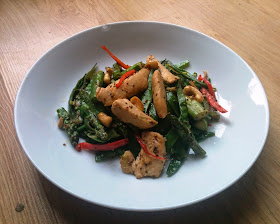After a quick bit of searching on amazon we came across the Clean & Lean Diet Book, written by James Duigan, which had fantastic reviews. Instead of supporting amazon we nipped down to Greenwich Waterstones and picked up a copy there.
For the past three days we've managed to abstain from the temptations of the birthday treats at work, alcohol and any other drink apart from water. We're not feeling too different yet, but we're certainly not feeling any worse so we'll keep on persevering!
Chicken, Asparagus and Cashew Nut Stir-fry from the Clean & Lean Diet book by James Duigan
Serves 2
1 skinless chicken breast, cut into 1cm strips
1.5 tablespoons vegetable oil
1 clove of garlic, crushed
25g cashew nuts
1 thin red chilie, thinly sliced
3 spring onions, sliced
125g asparagus, cut into small chunks
125g mangetout, cut length-ways
40ml chicken stock
1 tablespoon chia seeds (Hollands & Barratt sell these)
- Heat half the oil in a wok over a high heat. Add the chicken, cashew nuts and garlic and stir for 3-4 minutes until the chicken is nearly cooked and the cashews are lightly toasted. Tip into a bowl.
- Add the other half of the oil and throw in you chillie, spring onions, asparagus and mangetout. Stir for 2 minutes. Add the stock and cook for another 2 minutes. The stock will mostly evaporate.
- Add the chicken and cashew mix back into the wok for a final couple of minutes to warm back through. Stir in your chia seeds and add a squeeze of lime if you fancy.














